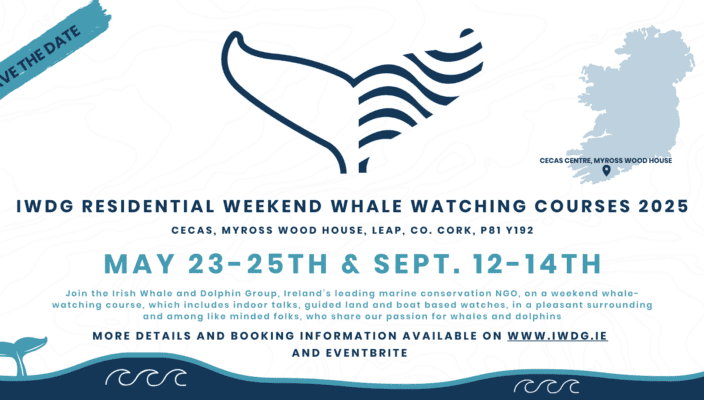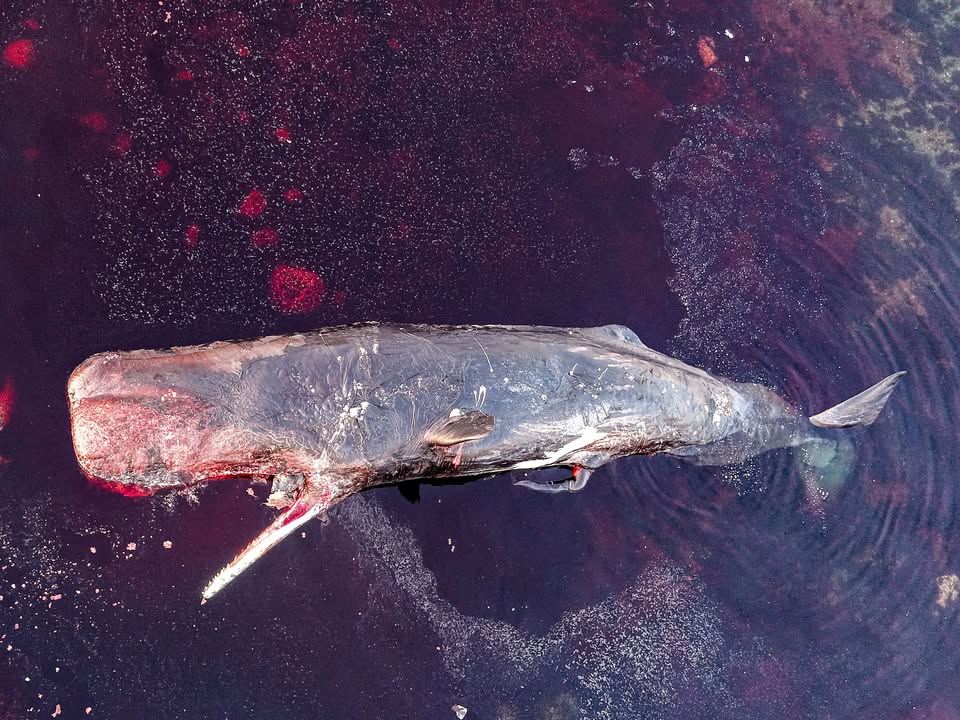Final Report IV:
A team from SMASS (Scottish Marine Animal Stranding Scheme) were on stand by to carry out an investigation of the sperm whale on Wed. 9th, alas it was taken back by the sea on a falling tide and the carcass was lost for a few days, until it came back ashore on the evening of Sat. 12th at nearby Kildavanan Pt. a little further to the north. By this time it was in an advanced state of decomposition, rendering it unsuitable for a necropsy or even girth measurements, which may have answered many of your questions as to the drivers underpinning this event. However, Elaine Maura, an SMASS volunteer did manage to visit it and measured it at an impressive 16.5 mts, which places it well within adult range and as is often the case with solitary sperm whales at these latitudes, it was a male. Nick Davidson off SMASS writes….”Given the teeth wear, and size we are pretty sure it was an old animal.” There is currently some discussion as to what next to do with the carcass, but you’d have to say that as it is a mature specimen, that will have all its bones well fuzed, that this could be a good candidate for burial with an eye on later retrieval, which ticks all the right boxes in terms of conservation, education and tourism.
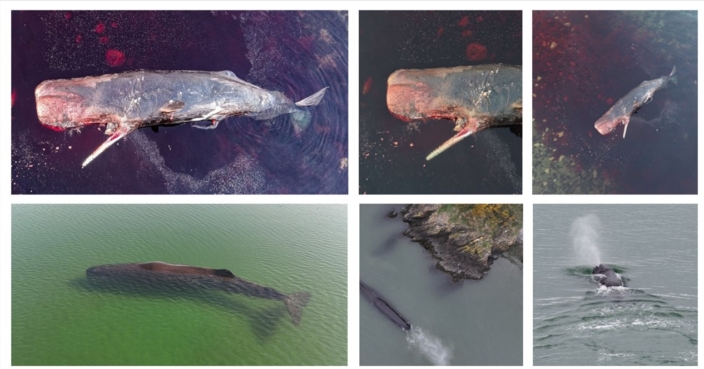
The final journey of the Waterford Estuary Sperm whale on the Scottish Isle of Bute
This story’s combined social media reach across IWDG platforms has been very high with >800,000 “views” on facebook alone. Of course this resulted in lots of strong opinions, some of which is best ignored. But there were also lots of good questions, which when distilled down, seemed to converge on three areas where people had genuine questions. They were:
- What was the cause of the whale’s death?
- Why did the whale end up in shallow waters?
- What happens to the whale after it passes away in shallow waters?
Q’s 1 & 2 are likely linked. The only way to establish cause of death is by a pathologist, in this case a marine mammal pathologist, carrying out a necropsy (or post mortem). In the case of whales, especially large ones, this will often be impossible, due to the sheer size of the animal and resultant complicated logistics, i.e. difficulty of access to the carcass. For instance, unless the body can be removed above the high water line, then the team will be unable to do much more than a cursory examination, before the tide returns to swamp the site and potentially take the carcass back out to sea. Although such brief examinations may be useful if the cause of death is anthropogenic (man made) with obvious lesions or traumas from events such as ship strike or entanglement in fishing gear, they’ll generally not reveal much if an animal is sick or has an underlying medical condition. It is within this vacumn that we can over-speculate and it does no harm to remind ourselves that most whales die of natural causes after long and healthly lives.
Q3. As to what happens when whales die? This very much depends on the circumstances i.e. the size of the whale and the local geography which determines access. But there will be occasions when the local authorities, which in Ireland means the County Councils, simply can’t get heavy lifting equipment onsite to either move or bury the carcass, as has happened recently with the fin whale in Clonea, Co. Waterford. In these circumstances, what happens is really down to mother nature, who will either reclaim it on the next storm or big tides, or unpleasant though it may smell, it will in time be scavenged and broken down by elemental forces. But if it can be accessed, then the local councils will often remove the carcass to an industrial incinerator for burning, as happens with large farm animals or diseased deadstock. If it is a very large whale such as a humpback or fin whale, the 50-80ft carcass may first need to be broken into smaller pieces so it can be safely transported. An option IWDG would always encourage, where logistically feasible and assuming the specimen is of adult age, is burial off site, with a view to later retrieval for public display. This option requires buy in from the local community, funding support and a little vision. Above all, it requires very understanding partners!
Of course none of the above should happen without IWDG having had the opportunity to visit the site in order to extract as much information as possible from the stranding. On occasion, when lots of ducks line up, it may be appropriate for a necropsy to be carried out, and these are often in assocation with the regional vet labs or researchers from 3rd level institutions. Alas, it seems no decision has as of time of writing been made regarding the Waterford Estuary/Isle of Bute sperm whale.
Montage images #1-4 courtesy of SDPhotographyBute, #5 Sarah Kim Watchorn, #6 Dave Somes
By Pádraig Whooley
IWDG Sightings officer
Report III: Breaking news. Wed. 9th April 2025…..The Waterford Estuary sperm whale died this morning on the Scottish Isle of Bute
We’ve just received the word from Dan Jarvis of British Divers Marine Life Rescue (BDMLR) that the whale died this morning (09/04/2025). A predictable end to a whale that was in a difficult situation for at least two weeks. It’s remarkable given the lack of food or suitable prey for this apex predator in the shallow waters of the Celtic Sea, Irish Sea and the North channel, that it somehow managed to travel so far and survive as long as it did. Its journey and suffering are now over.

Possible tracks between Waterford and final resting place on Bute, W. Scotland, courtesy IWDG
Report II (update) Tues. 8th April…..
IWDG can now confirm from images received by colleagues at BDMLR yesterday that the Sperm whale that entered Ettrick Bay, on the Isle of Bute, Scotland on Tues. 8th April is a match to the Waterford Estuary whale, which both entered and left the estuary on March 25th. We show below images for comparision which put this matter beyond doubt with identical markings on both sides around the dorsal fin and flanks.
As it swam out of Waterford Estuary on the falling tide, heading towards deeper water (still not nearly deep enough for a sperm whale), the impression from IWDG observers at the Hook Lighthouse and Dunmore East, was that it was swimming strongly, but we still had legitimate concerns for its survival and there was always a strong possibility that it would strand somewhere along the Waterford or Wexford coast. Alas, as the days became weeks without any further sightings we felt that the file on this incident could be put away. Not so, it seems.
It is most likely that it spent a number of days in the Clyde last week, entering Ettrick bay on Bute further to the north yesterday (Tues. 8th April) and as best we can establish was alive by night fall. We are still waiting for any updates to establish whether it survived the night. Its current location in Western Scotland now seems a lot more challenging than the situation it faced in Waterford estuary where on leaving the estuary it had a clear path south to deep water habitat and food. Its current location has it almost completely surrounded by land to the north, east and west and its only path out is south whence it came. After that, who knows. But given that two weeks and a minimum distance of c.500 KM later, it is really in no better a situation than it was when it rested off Arthurstown on the Wexford side of the estuary, you’d have to say that the odds of its long term survival are not good. We’ll endeavour to keep you posted here.
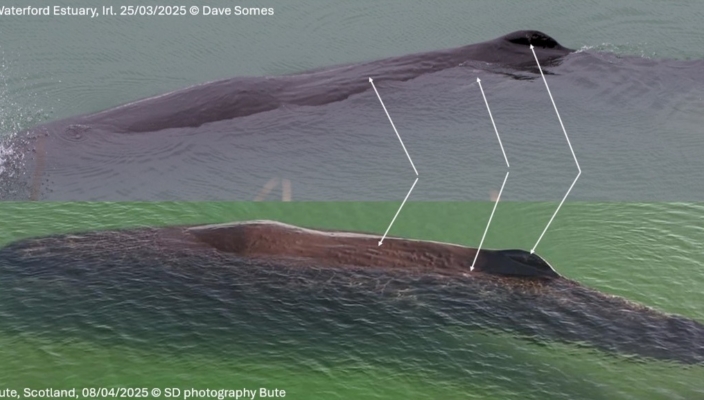
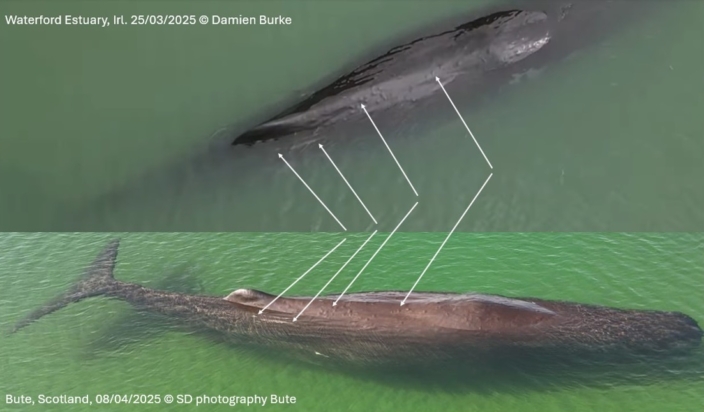
IWDG wish to acknowledge Steve Dick of SDPhotographyBute for giving us permission to use his images above
Report 1. 25th March 2025
To give today’s incident a little perspective, since the IWDG was established almost 35 years ago, we’ve documented 5,856 sightings of our smallest baleen whale, the minke, 2,111 sightings of our largest and fastest coastal whale, the mighty fin whale, and 1,705 records and counting, of our most charismatic whale, the humpback. All these big numbers reflect the fact that these rorqual whales do most of their feeding in inshore waters and hence we get to see them with some regularity.
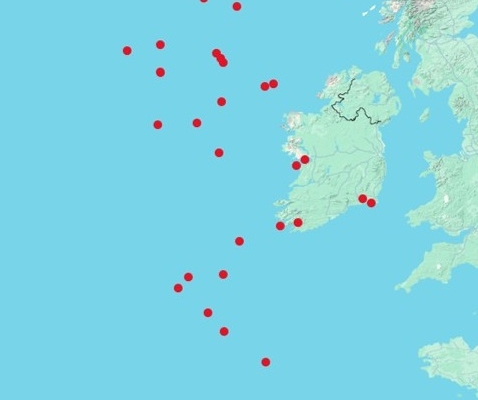
All 27 sperm whale sightings since 1990 courtesy IWDG
The sperm whale, the largest of the odontocetes or toothed whales, in sharp contrast isn’t so much a rare species, rather they are rarely seen, reflecting their habitat preference for deep canyon systems off the Continental Shelf Edge, where they think nothing of deep dives of 1-2 hours, taking them to depths of 2,000-3000 m. Such places are typically a long way offshore, (unless you live on Mayo’s, Mullet Peninsula), and so from the Irish south coast, you’d need to motor offshore at a good clip for some 8-10 hours before you’d find yourself in the zone and even then you’ve got your work cut out for you; as despite their being very audible with the right listening equipment (hydrophone) and easy to detect acoustically, sperm whales are notoriously difficult to detect visually, as let’s face it, they spend a lot more time at the bottom feeding on giant squid, than they do resting on the surface. The result is that we’ve only recorded sperm whales alive (as sightings) on a mere 27 occasions (see map).
Today was one such rare event, and these circumstances for good reason tend to bring out the pessimists in us, as experience tells us that sperm whales, at least healthy sperm whales are hardly ever recorded inshore, and sightings of them in a few metres of water in a place like Waterford Estuary, rarer still. So for good reason we go straight into “live stranding ” mode in preparation for the worst….not that there’s an awful lot that could be done to assist or refloat an adult sperm whale! Any care being of a palliative nature.
The one glimmer of hope we had today was a similar incident three years ago when on June 20th 2022 a sperm whale swam into Dursey Sound, west Cork and we waited for the inevitable news that it was grounded…. dying and dead. Alas, none of these things happened. It spent the day in the sound, then turned around and headed offshore, never to be seen again, dead or alive. We breathed a collective sigh of relieve as this was a bullet dodged. Today, it seems, we dodged another.

Earlier in the morning near Broomhill Pt. © Sorcha Maguire
The initial sightings report from Sorcha Maguire places the sperm whale in the estuary around 08:30am today, Tues. 25th March and this is the chronology of events as best we can piece them together
08:24 Logging and swimming near Broomhill point.
09:25 swimming west towards Passage east, then changed heading back towards the north side of the shipping channel close to Duncannon.
11:20 listing to one side close to Arthurstown pier, fishing vessel and kayak very close to whale.
13:11 Paddy Roche, ferryman …says whale still has water under it
14:00 big concern as reaching high tide now and if it remains where it is now, it will strand on falling tide.
15:00 Seems to be leaving the estuary with the falling tide. Fingers crossed.
16:00 IWDG Wexford & Cork members scope it from both Hook lighthouse and Dunmore East leaving the estuary.
16:30 our last report was from Brendan Glody, which puts it travelling at speed in a southwest direction about 1.5 miles south of Red Head on the Waterford side of the estuary entrance.
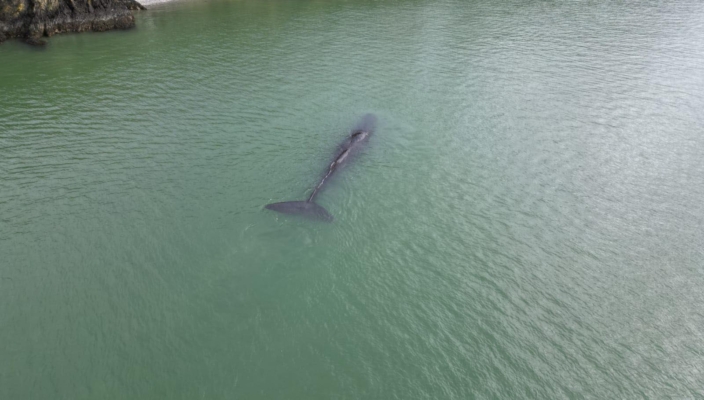
Arthurstown on the Wexford side around mid day 25/03/2025 © Damien Burke
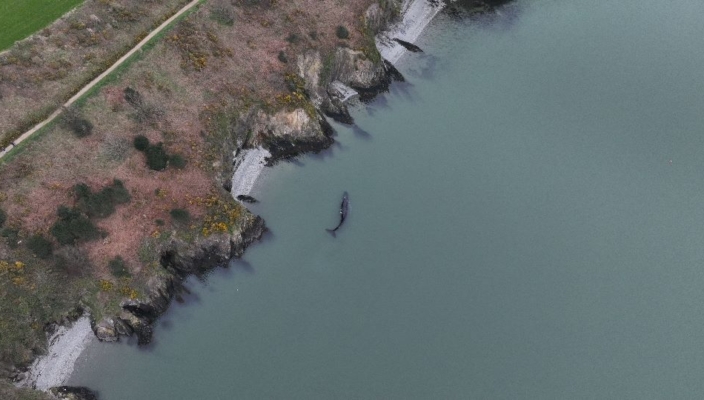
Arthurstown @ 13:00 25/03/2025 © Sarah-Kim Watchorn
And that is pretty much as much as we can share with you at this stage. If it continues travelling in a southwest direction, it should be out of sight tomorrow and as with the Dursey animal that will be it. However, there is another scenario from this very area we can draw on. On August 18th 2011 a sperm whale was recorded close inshore at Ballyteige Bay, Co. Wexford. The following day it had travelled west along 70 km of the Waterford coast before live-stranding on the Cunningar Spit near Dungarvan, where it finally died the following day (#3) at 04:00 am. Our man in Waterford, Andrew Malcolm still suffers from PTSD from this incident!
If our whale today opts to hug the coastline, then the Cunningar spit, could very well live up to its reputation as a natural navigational risk to already disorientated or weakened whales. The sperm whales’ echolocation capacities are adapted for vertical movements through the deep-water column and not for tracking along our shallow coastline, where it is in effect “swimming blind”. But its actions today suggest that it has the vitality and good sense to leave the estuary on the falling tide, which augurs well for further obstacles it may encounter in the days ahead.
As always, we’d ask members of the public to report any sightings of this whale (or others) to IWDG on www.iwdg.ie and if you are inclined to see the oceans top apex predator, then consider doing so from land…..Waterford has some wonderful elevated Atlantic promontories to whale watch from. If you happen to encounter it on a boat (or any craft), please be mindful that sperm whales, as with all whale species are protected from wilful interference and our suggestion would be that you’d maintain a minimum distance of 100 m and not spend longer than 15 minutes with it. Remember, this whale is not in its natural environment and is likely to be stressed or unwell and we ask that you give it space, both for its and your own safety.
IWDG would like to acknowledge the following among those who assisted in the reporting & recording of this incident: Sorcha Maguire, Paddy Roche, Stephen Burke, Deirdre Slevin, Maureen Jackson, Damien Burke, Sarah-Kim Watchorn, Local RNLI and Harbour Master.
Postscript.…..there have been no follow up sightings of this sperm whale over the past three days (26th-Fri. 28th March) since it left Waterford Estuary on the afternoon of Tues. 25th. This can only be interpreted as good news, as a whale of this size is unlikely to go unnoticed if it stranded on a local beach, (dead or alive). Let’s keep our fingers crossed.
By Pádraig Whooley
IWDG Sightings officer
